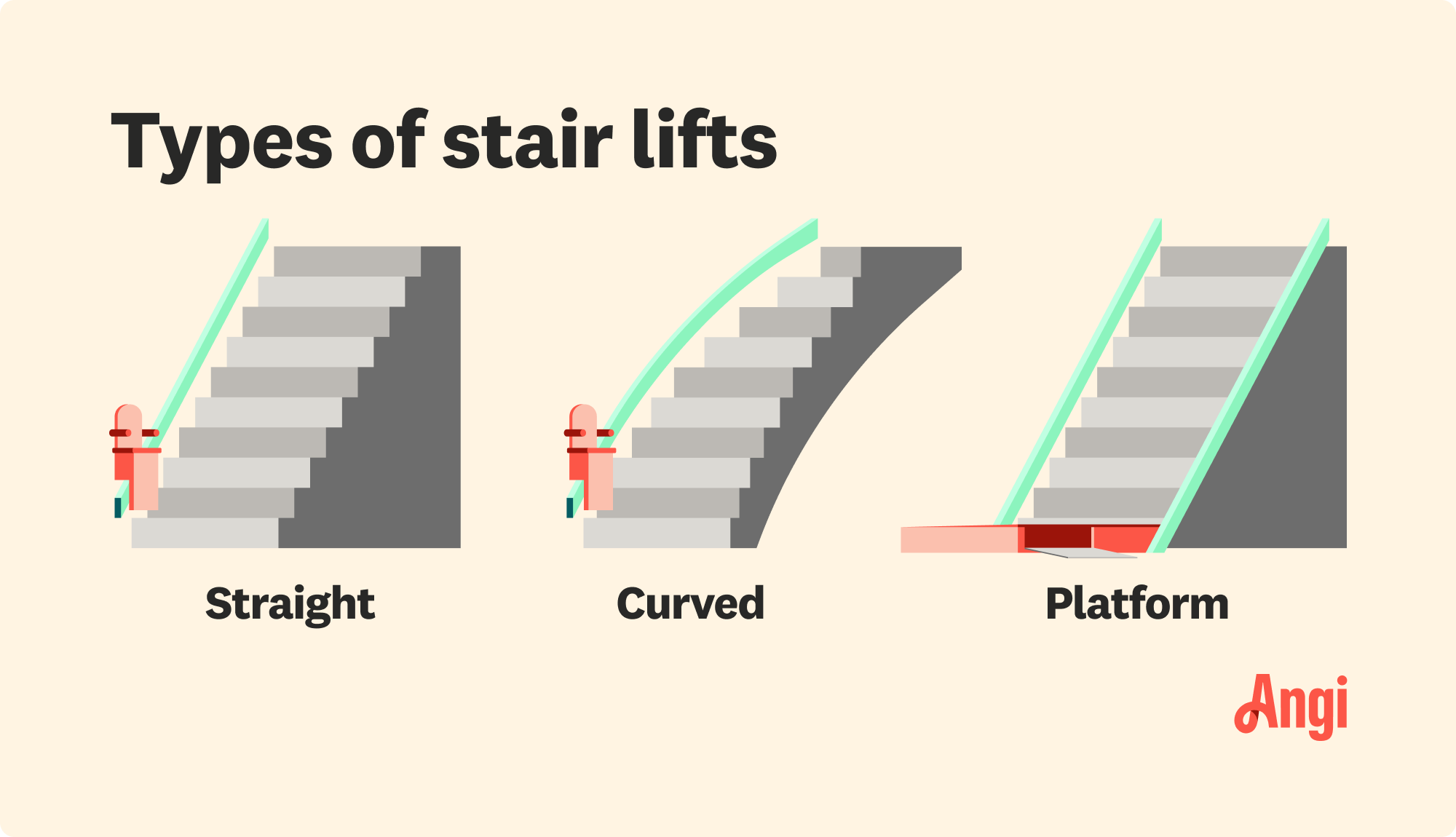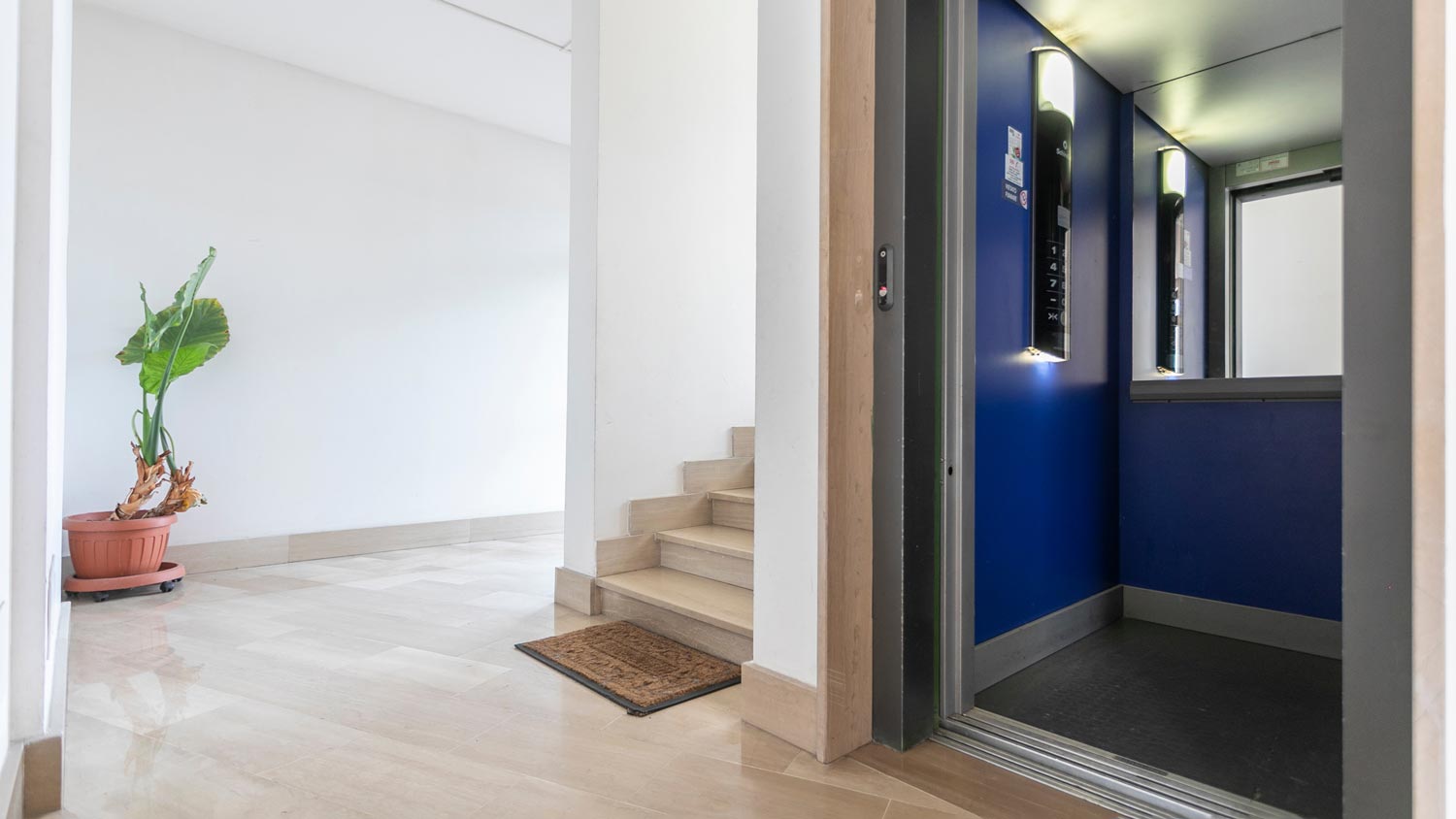
Home elevator costs depend on the size and type of lift, if it needs retrofitting, and the number of floors. Our guide outlines all residential elevator costs.
The average stair lift cost with installation is $7,050, and the typical homeowner will spend between $2,300 and $24,000 for a stair lift.


Straight stair lifts are the most affordable, costing $2,000 to $9,000, while curved or platform options can cost up to $25,000.
To save money, consider purchasing a used stair lift for $1,500 to $3,000, though they’re typically only compatible with straight staircases
Labor will account for 15% to 25% of your stair lift installation cost
Add-ons like safety obstruction detectors or powered foot rests can add $50 to $200 per feature.
Installing a stair lift often costs between $2,300 and $24,000, with the average homeowner spending $7,050 for a straight stair lift, including professional installation. A pre-owned stair lift can cost as little as $1,500, but be prepared to spend upward of $30,000 to install a curved or a lengthy outdoor stair lift.
To help homeowners with their next project, Angi provides readers with the most accurate cost data and upholds strict editorial standards. We’ve surveyed thousands of real Angi customers about their project costs to develop the pricing data you see, so you can make the best decisions for you and your home. We pair this data with research from reputable sources, including the U.S. Bureau of Labor Statistics, academic journals, market studies, and interviews with industry experts—all to ensure our prices reflect real-world projects.
Depending on the type, the cost of a stair lift runs between $1,500 and $30,000. The three main types of stair lifts are straight (the most affordable option), curved (the priciest option), or platform (the mid-range option). Other types to consider include used stair lifts and outdoor stair lifts.
Here’s what you might pay for each type of stair lift:
| Type of Stair Lift | Average Cost Range | Description |
|---|---|---|
| Straight | $2,000–$9,000 | Works with staircases that go straight up without any curved railings or intermediate landings; doesn’t require any customization |
| Curved | $10,350–$25,000 | Used for switchback staircases and those with curved railing |
| Platform | $5,000–$20,000 | Can accommodate a person who uses a wheelchair |
| Used | $1,500–$3,000 | Previously owned stair lift models save money; they must work as-is for your existing staircase |
| Outdoor | $4,000–$25,000 | Require more durable materials that can hold up against the elements, including rainy and wintry weather |

On average, expect to spend between 15% and 20% of your project cost on a local stair installer. For instance, installing a $6,000 stair lift may cost between $900 and $1,200 in labor, although prices can vary depending on the complexity, additional work required, and other factors.
Other factors could also influence the cost of your stair lift, including whether it’s electric or battery-powered, the type of seat, and upgraded features. Here’s what to expect for a few of these additional costs.
Power source: $4,000–$9,000 for an electric-powered straight stair lift and $3,000–$5,000 for a battery-powered stair lift
Type of seat: $2,000–$25,000 for collapsible, $2,500–$25,000 for perch, $2,500–$25,000 for swivel, $3,000–$25,000 for angled (all price ranges considering new stair lifts, either straight or curved)
Calling systems (handheld remote control): $50–$150, if not included
Seat belts: $50–$150 upgrade for a higher-quality, easy-grip or retractable lap belt
Full torso harness: $100–$250
Safety obstruction detectors: $100–$400
Powered foot and armrests: $50–$200
Specialty designs: $100–$500+
Backup battery for power outages: $50–$200
Drywall repairs: $300–$925, if needed after installation
Hiring an electrician: $50–$100 per hour, if needed for electric stair models
Also, note that if you don’t need a stair lift permanently, you might consider renting one instead. On average, stair lift rentals cost between $300 and $500 per month, and you may also need to pay a deposit ($500 to $1,000), installation fees ($400 to $700), and removal fees ($300 to $600).
Stair lift installation should always be left to a local stair service pro. That’s because incorrect installation could result in a malfunction, leading to falls or serious injury. Furthermore, warranties for stair lifts often require professional installation.
Here’s why you should hire a pro for this project:
Improper installation could lead to dangerous malfunctions, falls, or injury.
Pros ensure the lift is anchored to safely support the user’s weight.
They understand proper alignment and leveling.
Many manufacturers require professional installation to maintain the warranty.
Stair lifts must comply with safety regulations and local building or accessibility codes.
Pros verify that safety features (like sensors, brakes, and emergency stops) are working correctly.
Some installations may require electrical work or permits, which pros can handle for you.
Installing a stair lift can be expensive, but there are ways to keep costs low.
Consider a battery-powered model: Battery-powered stair lift models are about 30% to 40% less expensive than electric-powered ones. A battery-operated stair lift also means you don’t need to budget for an electrician, who might charge $50 to $100 per hour.
Purchase a used model: Pre-owned stair lifts are significantly more affordable than new lifts, coming in at $1,500 to $3,000, but they only work if they’re compatible with your existing staircase.
Buy a straightforward version: If your home has a curved or switchback staircase, it means you'll need to buy a more expensive, customized model. However, you can keep costs low by opting for a basic collapsible seat and avoiding any additional features, which may raise prices by $50 to $200 per feature.
Research financial assistance: While Medicare won’t cover the cost of a stair lift, you may be able to get help through Medicaid, the Veterans Health Administration, TRICARE, and the Department of Housing and Urban Development. In some cases, private insurance may also help with the bill.
Stair lifts don’t increase your home’s value. A small subset of homebuyers may need a stair lift, but most will remove it upon purchasing the home. If you’re planning to sell, it may be smart to remove the stair lift or advertise to potential buyers that you’ll cover removal costs.
You should always hire a professional to install a stair lift, as doing the job incorrectly could lead to malfunctions or injury.
Pros ensure safety, stability, alignment, code compliance, and more.
Save money by considering a battery-powered option or a used stair lift (if it works with your home).
Don’t forget additional costs like hiring an electrician for electric lifts, repairing drywall after installation, and more.
From average costs to expert advice, get all the answers you need to get your job done.

Home elevator costs depend on the size and type of lift, if it needs retrofitting, and the number of floors. Our guide outlines all residential elevator costs.

Recessed living rooms used to be popular but have fallen out of favor. This guide discusses the cost to raise a sunken living room to modernize your home.

Strong floor joists are the key to a structurally safe home. The cost of floor joist repair will often come down to what is causing the problem.

Discover the average home elevator maintenance cost, key price factors, and expert tips to help you budget for safe, reliable elevator upkeep in your home.

Aging in place house plans include ramping up wheelchair accessibility, lowering tall surfaces, and more. Follow these accessibility tips to get started.

Medium-density fiberboard is a commonly used material for various carpentry projects. Learn more about medium-density fiberboard costs for projects and more.